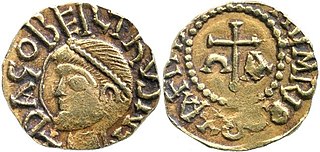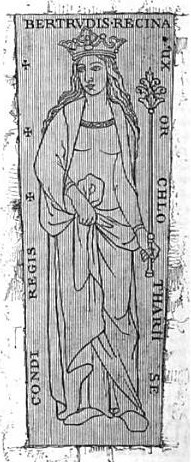Related Research Articles

Austrasia was the northeastern kingdom within the core of the Frankish Empire during the Early Middle Ages, centring on the Meuse, Middle Rhine and the Moselle rivers. It included the original Frankish-ruled territories within what had been the northernmost part of Roman Gaul, and cities such as Cologne, Trier and Metz. It also stretched beyond the old Roman borders on the Rhine into Frankish areas which had never been formally under Roman rule. It came into being as a part of the Frankish Empire founded by Clovis I (481–511). At the same time, the initial powerbase of Clovis himself was the more Romanized part of northern Gaul, lying southwest of Austrasia, which came to be known as Neustria.

Dagobert I was King of the Franks. He ruled Austrasia (623–634) and Neustria and Burgundy (629–639). He has been described as the last king of the Merovingian dynasty to wield real royal power, after which the Mayor of the palace rose as the political and war leader. Dagobert was the first Frankish king to be buried in the royal tombs at the Basilica of Saint-Denis.

Neustria was the western part of the Kingdom of the Franks during the Early Middle Ages, in contrast to the eastern Frankish kingdom, Austrasia. It initially included land between the Loire and the Silva Carbonaria, in the north of present-day France, with Paris, Orléans, Tours, Soissons as its main cities.

The Kingdom of the Franks, also known as the Frankish Kingdom, the Frankish Empire or Francia, was the largest post-Roman barbarian kingdom in Western Europe. It was ruled by the Frankish Merovingian and Carolingian dynasties during the Early Middle Ages. Francia was among the last surviving Germanic kingdoms from the Migration Period era.

Dagobert II was a Merovingian king of the Franks, ruling in Austrasia from 675 or 676 until his death. He is one of the more obscure Merovingians. He has been considered a martyr since at least the ninth century.

Theuderic III was King of the Franks in the 7th century. He ruled Neustria and Burgundy on two occasions, as well as Austrasia from 679 until his death in 691.

Childebert III the Adopted was a Frankish king.
Sichilde was a Frankish queen as consort to Chlothar II from 618–627.
Gundoin was the first Duke of Alsace in the middle of the seventh century. He was a Frankish nobleman from the Meuse-Moselle basin. He was, according to the author of the Vita Sadalbergae, an "illustrious man, opulent in wealth and fame according to the highest secular dignity and skilled in courtly affairs."
The Duchy of Alsace was a large political subdivision of the Frankish Empire during the last century and a half of Merovingian rule. It corresponded to the territory of Alsace and was carved out of southern Austrasia in the last decade of the reign of Dagobert I, probably to stabilise the southern reaches of Austrasia against Alemannia and Burgundy. By the late Middle Ages, the region was considered part of Swabia.

Bertrude was a Frankish queen consort from 613 to 618. She was married to Chlothar II.

The Battle of Lucofao was the decisive engagement of the civil war that afflicted the Frankish kingdoms during and after the reign of Dagobert II (676–79). In the battle, the Neustrian forces of Theuderic III and his majordomo Ebroin defeated the forces of Austrasia under the dukes Pippin and Martin.
Brunulphe II or Brunulphe II of the Ardennes also called the Younger, was a Frankish nobleman and Merovingian Count of the Ardennes.
Alberic of the Ardennes, Alberick, or Albéric l'Orphelin de Hainaut d'Ardenne, also called the Orphan, was a Frankish nobleman and Merovingian Count of Hainaut.
Brunulphe or Brunulphe of the Ardennes was a Frankish nobleman and Merovingian Count of the Ardennes.
Saint Walbert IV(French: Sainte Walbert IV), also known as Vaubert, Waubert, or Waudbert was a Merovingian Count of Hainaut and a Frankish saint. He was the father of Saint Waltrude, and Saint Aldegund, first abbess of Maubeuge.
Walbert I, Vaubert, Waudbert, or Vautier also known as Walbert of the Ardennes was a Frankish nobleman and a Merovingian Count of Hainaut.
Walbert II also called the Younger, was a patrician, Roman senator, and Merovingian Count of Haynau and of the Ardennes.
Hydulphe, Hydulphus, Hidulphe, Hidulf, commonly known as Hydulphe of Lobbes(French: Hydulphe de Lobbes) was a Frankish saint who helped Saint Landelin establish Lobbes Abbey, Crespin Abbey, and Aulne Abbey.
Walbert III was a Frankish nobleman and a Merovingian Count.
References
- 1 2 Le Carpentier, J. (1668). Histoire genealogique de la noblesse des Païs-Bas, ou Histoire de Cambray, et du Cambresis,: contenant ce qui s'y est passé sous les empereurs, & les rois de France & d'Espagne; enrichie des genealogies, eloges, & armes des comtes, ducs, evesques ... : le tout divisé en IV. parties. Netherlands: chez l'Autheur.
- 1 2 3 Jeantin, J. F. L. (1851). “Les” chroniques de l'Ardenne et des Woepures: ou revue et examen des traditions locales antérieures au onzième siècle. France: Maison.
- 1 2 3 4 marquis de Fortia d'Urban, A. J. F. (1838). Histoire des Lorrains. France: chez l'auteur.
- ↑ Masson, F. A. (1861). Annales Ardennaises ou histoire des lieux qui forment le deṕartement des Ardennes et des contrées voisines. (n.p.): Lelaurin.
- ↑ Vinchant, F. (1853). Annales de la province et comté du Hainaut. Belgium: A. Vandale.